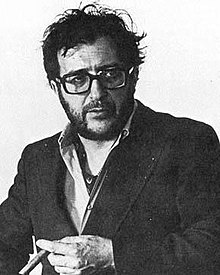Coro (Berio)
| Coro | |
|---|---|
| by Luciano Berio | |
 Luciano Berio, at the time of the composition. | |
| Composed | 1974—1976 |
| Published | Ricordi |
| Duration | Approximately one hour |
| Movements | 31 |
| Scoring | 40 voices and 40 instruments |
| Premiere | |
| Date | 24 October 1976 |
| Location | Donaueschingen |
| Conductor | Luciano Berio |
| Performers | WDR Rundfunkorchester Köln WDR Rundfunkchor Köln |
Coro (Italian: Chorus) is a large scale composition for forty voices and forty instruments by Italian composer Luciano Berio.
Composition[]
Coro was written at a time when, according to Berio, "the blood in the streets of Italy came out", partly due to the Years of Lead. Berio, a composer committed to social issues, often expressed his views and described the composition's central theme to be "the acute awareness of things at a tragic moment. On this line, he referred to Coro as being a tribute to Chilean poet Pablo Neruda. In his opinion, Neruda was "practically murdered (not physically, but spiritually); they broke his heart. [...] It is an invitation to be aware of the violence of the times, Fascist violence".[1]
Berio composed Coro between 1974 and 1976 under a commission by the Westdeutscher Rundfunk Köln. It was dedicated to his wife, Talia Berio. Its premiere took place in Donaueschingen on 24 October 1976 by the WDR Rundfunkchor Köln and the WDR Rundfunkorchester Köln. However, Berio only premiered an initial version of Coro, which contained 29 movements. The final 31-movement piece was premiere later in Graz, on 16 November 1977, by the Vienna Radio Symphony Orchestra and Chorus, under the baton of Leif Segerstam.[2]
As customary in Berio's musical output, Coro has its place in a sequence of works whose titles refer to archetypal modes of musical expression. He started this sequence with his Sinfonia (1968–1969), followed by his outlook on the whole genre of music theatre in (1960–1970), on the life and work of a solo singer in Recital I (for Cathy) (1972) and on the relationship between soloists and ensembles in his (1972–1973).[3] With Coro, Berio also further explored the kind of folk music he had already used in his Folk Songs (1964) and (1969).[4]
Structure[]
Coro is divided into 31 untitled movements of varying duration and takes around an hour to perform. Following is a full breakdown of the movements, with their duration as specified by Berio in the original score.
| Movement | Incipit | Duration | Tempo |
|---|---|---|---|
| 1 | "Today is mine. I claimed to a man" | — | ♩ = 60 (ma sempre molto flessible) |
| 2 | "Venid a ver" | 1:25 | ♩ = 64 |
| 3 | "Your eyes are red" | 0:30 | ♩ = 114 |
| 4 | "Venid a ver" | 0:06 | ♩ = 104 |
| 5 | "Your eyes are red" | 1:30 | ♩ = 84 |
| 6 | "Venid a ver la sangre por las calles" | 0:20 | ♩ = 104 |
| 7 | "Wake up, woman, rise up, woman" | 1:40 | ♩ = 104 |
| 8 | "Venid a ver la sangre por las calles" | — | ♩ = 72 |
| 9 | "I have made a song" | — | ♩ = 72 |
| 10 | "Venid a ver la sangre por las calles" | — | ♩ = 68 |
| 11 | "I have made a song" | 2:05 | ♩ = 84 |
| 12 | "Venid a ver la sangre" | 0:30 | ♩ = 84 |
| 13 | "Wake up, woman, rise up, woman" | — | ♩ = 96 |
| 14 | "Venid a ver la sangre" | 0:35 ca. | ♩ = 60 |
| 15 | "Komm in meine Nähe" | 0:30 | ♩ = 60 |
| 16 | "Today is mine. I claimed to a man" | 2:10 | ♩ = 84 |
| 17 | "Pousse l'herbe et fleurit la fleur" | 1:15 | ♩. = 84 |
| 18 | "Go, my strong charm" | — | ♩ = 116 |
| 19 | "It is so nice, a nice one gave a sound" | 1:35 | ♪ = 160 |
| 20 | "Your eyes are red" | — | ♩ = 94 |
| 21 | "Mirad mi casa muerta" | — | ♩ = 74 |
| 22 | "Je m'en vais où ma pensée s'en va" | — | ♩ = 72 |
| 23 | "Pousse l'herbe et fleurit la fleur" | 1:20 |